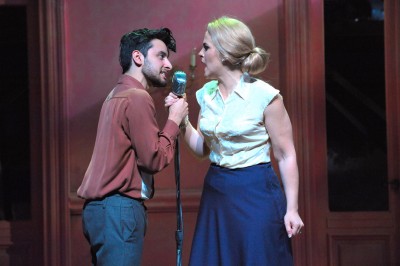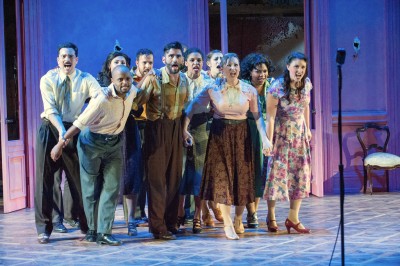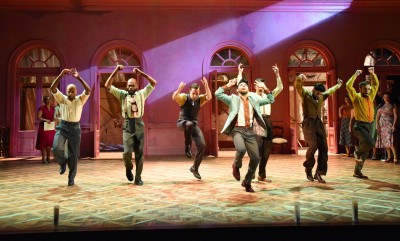When musical director Chris Youstra talks “Evita,” the Tony® Award-winning Andrew Lloyd-Webber/Tim Rice musical he is staging at Olney Theatre Center, he cannot help lyric-checking the modern-day musical theater phenomenon and current eponymous Broadway juggernaut.
“You know that song in ‘Hamilton,’” he asked. “‘Who lives, who dies, who tells your story?’
“This is not the story of Eva Perón—it is Che’s story, and his biases and subtext,” said Youstra, referring to Argentina-born revolutionary Che Guevara, the musical’s rather anachronistic narrator. “It’s like the story of Pocahontas being told by Captain John Smith.
“What’s on the page is on the page,” he added, “yet misogyny, especially when it comes to strong women, is easy to see today. And the idea of how much a point of view can affect a legacy—one tweet, and boom—that’s a pivot point of both stories.”
Like “Hamilton,” “Evita” got its start as a concept album (the 1970s version of a mixtape); it moved first to the West End of London and then to Broadway, where it made a superstar of a young actress named Patti LuPone. Like “Hamilton,” “Evita” tells the story of a self-made, scandal-ridden populist hero from the point of view of a famous nemesis. And—again, like “Hamilton”—this particular version of “Evita” seeks to change the way its audience looks at history.
“It’s certainly not a historically factual telling of Eva Duarte Perón’s story,” Youstra observed. “Yet 90 percent of people who know her story know it from this.”
It’s complicated

Her story, in a nutshell, reads like a political fairytale: Perky peasant from the pampas makes her way to Buenos Aires, becomes an actress and catches the eye of the most powerful papi in the land. She ends up married to the president of Argentina, becomes beloved—and also hated—when she reigns simultaneously as a compassionate First Lady and a behind-the-scenes manipulator with breathtaking amounts of usurped power. And when she dies at 33 at the height of her fame, Eva Duarte Perón becomes a sanctified symbol of hope and compassion, all but officially beatified by the people of Argentina.
“She was a person who wanted things and was unapologetic about getting them,” mused Rachel Zampelli, who plays the title role. “You hear people argue: ‘She had the spirit of a man!’ ‘She had the spirit of a woman!’
“No: she had the spirit of a powerful person. Forget about what she had between her legs!”
For Zampelli, deconstructing the political and feminist aspects of Eva is secondary to the main goal of telling her story—and telling it in context.
“On day one, Will (director Will Davis) said, ‘There’s a Madonna/whore thing’ with Evita,” Zampelli remembered. “The way she’s been portrayed, she’s either this or that: saint or sinner, no in-between.
“I find that uninteresting and antiquated.”
And so this Eva—this Evita—is imbued with complexity. The concept of a love-her-or-hate-her First Lady embarking on a campaign to achieve legitimate political power in her own right, as Eva briefly did, obviously has strong modern associations, and Zampelli said she “can’t ignore that.”
Especially when Eva Perón’s political legacy includes shepherding the women’s suffrage movement in Argentina, and forming the Female Peronist Party once women achieved the right to vote in 1947. Zampelli, a Bowie native who studied theater at Santa Clara University, is quick to point out that “Evita” is not a factual account of the life of a woman whose success was unprecedented.
“You’re hearing what Che wants you to know.”
The luckiest people

While Zampelli makes this Evita her own, she says she came to it without being aware of its history: a musical with a lead that is notoriously difficult to sing (LuPone famously called it “a part that could only have been written by a man who hates women”), narrated by a controversial figure who is actually a fictitious amalgam of a character.
“I had a lot to say about this play and this person,” the actor recalled. “There are so many inaccuracies here, and I wanted to honor her—I wanted to be true to her.”
In the theatrical context, Zampelli is able to do this with the help of a creative team that has allowed the leads and ensemble cast to create something unique on a relatively minimalist (for a Lloyd-Webber work, anyway) stage.
“We are the luckiest people in the world to have Christopher d’Amboise,” she pointed out, referring to the Tony® Award-nominated dancer who worked with George Balanchine and Jerome Robbins as a principal lead in the New York City Ballet before turning his attention to stage choreography. “A big part of what makes this version of ‘Evita’ unique is the choreography, and the use of the ensemble as almost a character in and of itself.”
D’Amboise moves the action along via his dancers, sometimes using one movement to convey a world of emotion, and Zampelli notes that at the curtain, the entire cast bows together.
“I love it,” she said, with no trace of any Eva-diva in her voice. “That’s what we created together, and how fitting, in a story—with a character— that’s all about the people.
“To make ‘the people’ secondary just wouldn’t be right.”
And to put the people first, Youstra says, director Will Davis made Che central.

“What’s fresh is that Che is actually manipulating the ensemble to tell the story,” he pointed out.
“While millions of people saw her as a saint, this lens Tim Rice and Andrew Lloyd-Webber used didn’t see it the same way.
“Don’t forget, in ‘Jesus Christ Superstar,’ their point of view was through Judas!”
Youstra agrees that this particular “Evita” is “a very ‘dance-y’ production—highly choreographed, with a young cast and a distinct, evocative look.” And yet, as musical director, he understands that it’s the classic songs of “Evita” that the audience wants to hear.
“It’s hard to get away from the fact that ‘Don’t Cry for Me Argentina’ is considered the pivotal song,” he said. “But, really, ‘Oh, What a Circus’ and ‘Heaven on Their Minds’ do so much to communicate what’s really going on.”
The music, the movement, the emotion—Youstra feels confident that the creative team and the cast have truly made an enduring show their own, making sure to answer the “…who tells your story?” question in intelligent, interesting ways.
“It’s ‘Evita’ with a fresh take,” he said. “We’re trying to bring the story you like, but also have a different angle.
“It’s a tricky balance—and it’s unlike any version of ‘Evita’ you’ve ever seen.”
“Evita” runs through July 31 at Olney Theatre Center, 2001 Olney-Sandy Spring Road, Olney. Performances are at 8 p.m. Wednesdays through Saturdays, and 2 p.m. matinees on Sundays as well as on Saturday, July 13. Tickets range from $38 to $75. Call 301-924-3400 or visit www.olneytheatre.org